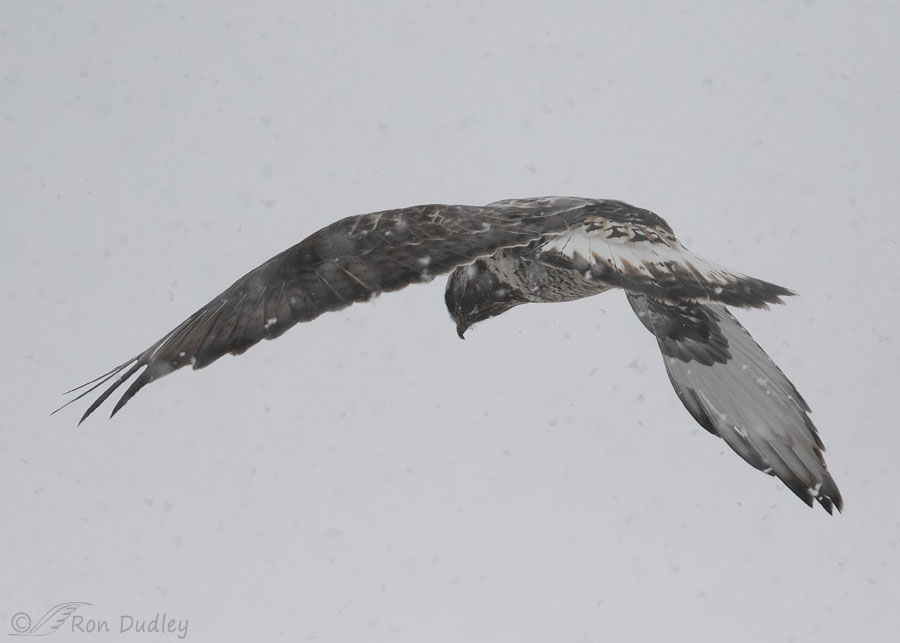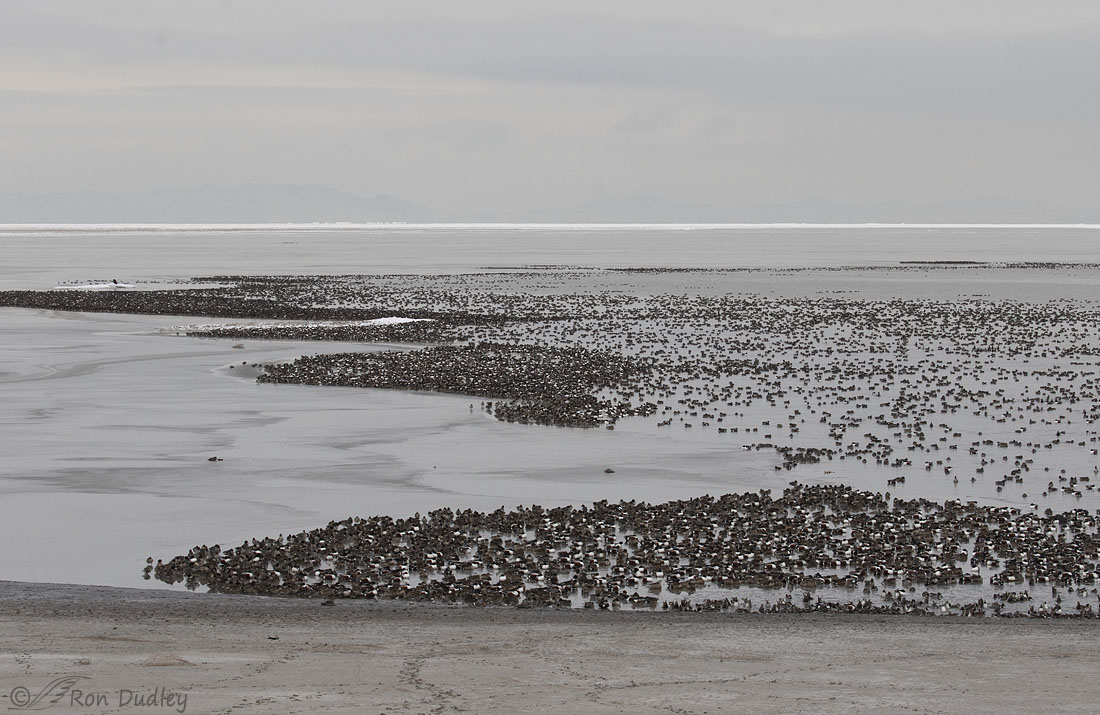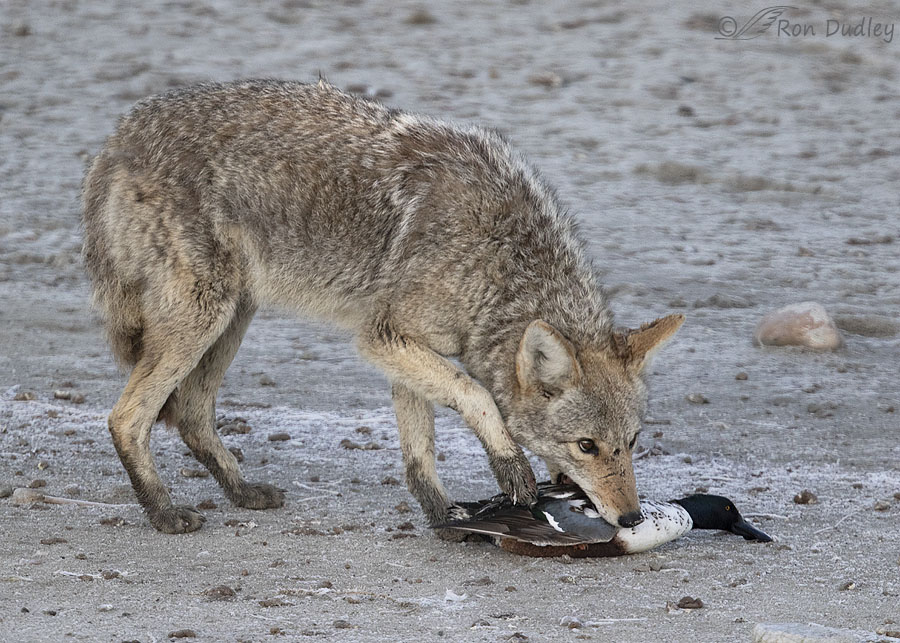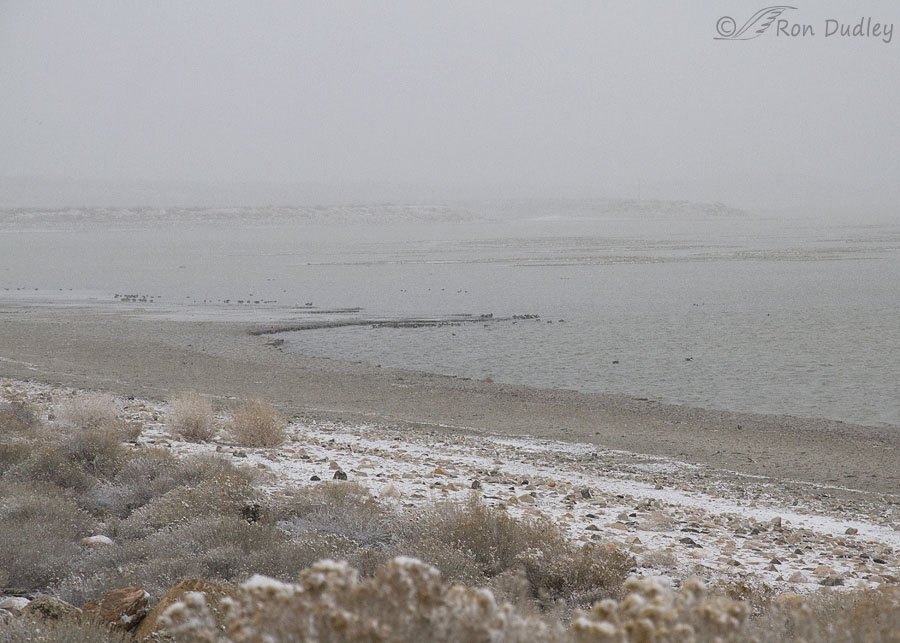Yesterday morning I had two goals when I made a trip to Antelope Island as a snowstorm was moving in from the north. One of them was to see if I could get lucky with some photos of birds or wildlife in falling snow. That kind of shot can be pretty interesting but a lot of things have to come together to make it happen and yesterday nothing did. So I struck out.
I found almost no birds and only one coyote that crossed the road in front of me and disappeared in the snow. It was often very dark and foggy to boot.

The only photos I took with my big lens were of this Rough-legged Hawk hovering with its back to me. Yes, I got falling snow in the photo, but shooting conditions were so poor there’s not much else I like about the photo. Besides, it’s a butt shot.
So I turned my attention to my second goal.
Readers will remember that recently I documented ducks, mostly Northern Shovelers, along the Antelope Island causeway that were somehow disabled to the point that coyotes could, and did, walk right up to them on the beach without the duck making any attempt to escape. Over several days I documented coyotes picking up up three still-living ducks, beheading them and eating their heads, and then usually abandoning the rest of the carcass.

At the time there were hundreds of thousands of ducks near the shore (this is only a portion of them) and oftentimes there were many hundreds of ducks actually on the shore, usually sunning themselves when the sun was out.

A few, not many but a few, of those ducks were disabled but I didn’t know it until a coyote would saunter along and walk right up to one those ducks that could not escape, as if it was paralyzed.
The big question of course was what was causing the ducks to be disabled? They had no apparent injuries before the coyote got to them and they were obviously still alive when the coyote beheaded them. In my previous post I speculated that it might be botulism. It was only a wild guess but the symptoms seemed to fit (apparent paralysis) and I knew that at certain times of year botulism is a common problem with birds along the lakeshore.
So late last Friday afternoon I called Trish Ackley, Park Naturalist at Antelope Island State Park, and asked her if she know what could be disabling the ducks. At the time she was unaware of the problem but after seeing my photos (I sent her the links to my posts) she was absolutely intrigued, and curious, so she said she’d forward my post links to Steven Bates, Wildlife Biologist at Antelope Island State Park, to see what he thought.
So yesterday my second goal was to pay Trish a visit to see what she may have found out.

Before we go any further, this is what the same stretch of beach looked like yesterday morning at the beginning of the snowstorm. There was only a couple of hundred ducks near the shore, with more of them much further out or dispersed to other areas of the lake. Using my big lens I scanned the shore carefully looking for disabled ducks but didn’t notice any. After I took this photo I visited with Trish. I was really curious about what Steve might have had to say.
Trish had sent Steve the links to my posts and asked him if botulism could be the cause of the ducks being disabled. His response was short and to the point – “Tis the season. Botulism will be running rampant before long. Sounds like it has started.”
Coming from Steve I take that as near-confirmation that Clostridium botulinum is the culprit – botulism. I’m sad for the birds that it’s returned but glad to know the likely answer.
Thank you Trish and Steve, for your dedication to the critters on the island and for your receptiveness to all of my possibly annoying questions.
Ron


I can’t but think that the botulism situations happening to birds at the Great(?) Salt Lake and the Klamath basin are worsened to a greater or lesser degree by human greed. I have read that the future will be rife with wars over water; it appears that birds are already the innocent victims.
I didn’t get a chance to comment on yesterday’s Eagle. In addition to being a beautiful photo, one wonders what Thanksgiving would be like if Ben Franklin’s preference had prevailed.
Just the comments alone provide such an education! Thank you for following up.
Thanks to my readers!
We have sen botulism in the Muscovy ducks at our Florida home. Some could not keep their heads above water. They would paddle to shore and let their heads rest on the ground. Also, the head is said to be a greatly concentrated source of energy. Kestrels start by eating the heads of mice. (I have seen it with this species but think other raptors do this as well).
Interesting, Kenneth.
From the journal Lydia referred to about the rehabbers who saved thousands of birds dying from botulism at Tule Lake NWR: “Their heroic work has brought national attention to the problem of insufficient water allocation for wildlife in the refuge.”
So, this is all part and parcel of the Great Salt Lake’s slow death from poor water (and other) management practices? Just … horrendous. Agonizingly horrendous.
Chris, I’m sure the botulism situation has been aggravated by our current water situation but it’s been a problem pretty much every year – high water years or low water years. At least that’s my understanding.
Wow! Who knew the morning check-in to FP would turn into a graduate seminar on avian diseases and water management issues! Thank you, Ron, for introducing the subject, and thanks to Louise and Lydia for the links to very informative sites.
Much appreciated, Carolyn.
How often do these Botulism epidemics occur on Antelope Island?
John, they occur every year in areas around the shore of Great Salt Lake, including but not limited to the island.
Fascinating, but also very, very sad.
Thank you, and Trish and Steve. I hope the season is short lived. Very short lived.
Thanks, EC.
There are 7 strains of botulism and 2 of those affect birds. Ducks, geese and loons are the most commonly affected species but it can occur in other birds. Humans, dogs (including coyotes), cats and a few other mammals are relatively immune to the strains causing avian botulism so the coyotes are likely not harmed. Muskrat and mink are known to be sometimes affected. Avian botulism accounts for 10,000-50,000 bird deaths (mostly waterfowl) each year worlwide. In some bad years more than 1,000,000 birds have dies from this disease.
Very useful info Dan, thank you!
In some years we have more birds than “10,000 – 50,000” dying from botulism here in Utah alone.
Ron, I know a woman Marie Travers, who works with a wonderful group of bird rehabilitators that have rescued thousands of birds with Botulism in various states. She contributed to the research and method as to how this process works. It’s an ingenious process and very simple. If you would like more information I would be happy to have her contact you. Their article is in the journal below. Thank you, Lydia
https://wildhope.org/wp-content/uploads/flipbook/Vol10/mobile/index.html
Lydia, thank you for the info and for the link.
PS Here’s a good website: https://www.usgs.gov/centers/nwhc/science/avian-botulism It says it doesn’t effect humans who might eat the duck, so maybe it doesn’t impact coyotes?
Thanks for the link, Louise.
Thanks very much, Ron, for providing this follow-up information. When I saw the initial photos of so many birds packed together, I thought, there’s a petri dish ready to explode. It obviously did.
“A petri dish waiting to explode”
A good way to put it, Nanci – although I have to wonder if botulism is population density dependent. I believe they get the toxin from the anaerobic mud, not directly from other birds.
Interesting and concerning. I always thought that botulism needed warm conditions to thrive – basically, a duck dies (botulism in the soil and in invertebrates eaten), then fly maggots from the carcass float in the water and are eaten by other ducks. Did the ducks you saw the coyote get demonstrate the classic ‘limberneck’ flaccid paralysis – unable to lift the head? Maybe the warm weather is necessary for the maggot proliferation which causes it to spread into an outbreak huge numbers of ducks – where wildlife managers then need to drain lakes/ponds etc for a while to treat it. And primary response is picking up the dead carcasses before the maggots can proliferate.
Louise, yes – they were struggling to lift their head. As I recall our outbreaks tend to be at their worse in warmer weather.
My question is: Can the Coyotes get sick from eating sick ducks? Also one of the reasons why the Coyotes just eat the heads and leave the rest, could be that there are vitamins and minerals in the eyes that maybe the Coyotes crave. There is a well documented story about a shipwreck survivor who in time, started to consume only the eyes from the fish he was able to catch. Without knowing it, his body craved the vitamins that only that area of the fish could provide, and he found himself craving only that part of his catches.
René, see Dan Gleason’s comment above.
Once again this proves the worth of Feathered Photography, and of course it helps that our photographer is a biologist and a very curious one at that. Great job Ron. Really appreciate the education and information along with the great photos.
Thanks very much, Everett.
Can any thy ever done to treat the birds or mud to prevent this? Do the birds die from this?
Linda, not that I know of and yes. Sometimes by the thousands.
Check out the article Lydia referenced: https://wildhope.org/wp-content/uploads/flipbook/Vol10/mobile/index.html
The birds can be treated – basically by antitoxin and then flushing the toxin out of their system – but it’s very labor intensive and stressful. Proventing keel sores, supporting their neck, getting them into water asap and addressing water-proofing issues… long and involved. You can’t treat the mud; when there are thousands of birds dying, the primary treatment is getting the carcasses of those that have died out of there to prevent the others from eating the affected maggots.
I guess my question is: if the ducks are paralyzed by botulinum toxin, then what happens to the coyotes when they eat them?
The toxin binds to the neurotransmitters rendering it non-toxic for the coyotes?
And how/why is the organism able to produce to the toxin? It required anaerobic conditions? And warm temps?
Nicole, see Dan Gleason’s comment above.
Like Judy, I’m wondering– if the culprit is botulism, are the coyotes susceptible
to it also ? And the mystery of the head-only consumption still hangs in the
air…….what questions your morning of observation have raised !
Chris, see Dan Gleason’s comment above.
Poor ducks! Hopefully, the conditions in the mudflats will change soon and botulism season will be short.
I wonder if the coyotes know that there’s something hinky with the ducks and that’s why they’re only eating the heads. I don’t think that the botulism toxin can cross the blood-brain barrier. They might nibble at some of the rest of the bird, but not make a full meal of it — I’m curious as to what’s happened to the carcasses they left the other day.
“I’m curious as to what’s happened to the carcasses they left the other day.”
So am I, Marty. Yesterday I thought about going out there and climbing among the rocks to find out but thought better of it.
Glad you got an answer. SO, it appears it does not affect the coyotes?
Not that I know of or saw evidence of, Judy.
Hi Ron, Has the bird flu outbreak that is happening on the east coast (and recently detected in Kentucky) reached Utah? That impacts wild birds, including ducks, as well as commercial poultry. I volunteer at a wild bird rehab in Delaware, they are currently under quarantine and can’t accept new patients because of the bird flu. It’s highly contagious, wondering if wildlife folks there are monitoring for it?
“Has the bird flu reached Utah”
Not that I know of, Pat. See my responses to Terri and Steven below.
Even as a retired teacher you still inform and inspire research!
My first thought was possible crashing into the salt. I remember pelicans and swans were doing that a few years back and being disabled, even killed in the fall.
Second thought was rice breast (Sarcocystis). Quick research shows that was extremely slim.
Thank you, Shane. From what I saw their symptoms seemed most like paralysis rather than injury caused by crashing into the ground.
Great follow-up to the disabled duck post. Gotta love curiosity, questioning and the urge to find answers. I too was wondering if the botulism might have contaminated the body but not the head, but then realised that botulism could still affect the skin and muscles in the neck, cheek and eye and possibly also the tongue and throat, so . . . ? Still wondering.
I’m curious. Why would a coyote only eat the duck’s head?
Christine, that’s the second primary question. Still don’t know the answer to that one.
One time a coyote did eventually come back and eat some of the rest of the duck but the other times they didn’t, at least not while I was there and I was there for a long time. It may have been food-caching behavior but that’s only a guess.
Feels like a hanging cliff story, so is botulism more dangerous in the winter which is on grasses eaten by the ducks? I need to highly recommend an excellent book I’m reading (published in 2005 as a hardcover but recently available in kindle version) which discusses avian flu among wild ducks among many other issues. With more industrial large-scale chickens and hogs internationally and their sewage problem, mixing with ducks/geese downstream/upstream of sewage problems and industrial meats, it’s a horror story that network news isn’t covering. Book is titled “The Monster at our Door” by Mike Davis.
Terri, Clostridium botulinum is an anaerobic bacteria, meaning it can survive only in the absence of oxygen, so it wouldn’t be found on grasses. It thrives in the anaerobic conditions of lake mud at certain times of the year. See my response to Steven below.
You might also consider the possibility of avian flu. It’s killed thousands of birds in Israel this year and is now, apparently, infecting many in commercial poultry farms in the Upper South.
Steven, I considered avian flu and several other avian diseases and I’m sure Steve did too. But Clostridium botulinum produces a neurotoxin that causes symptoms that seem to best fit the symptoms I saw in these physically disabled, essentially paralyzed, ducks.